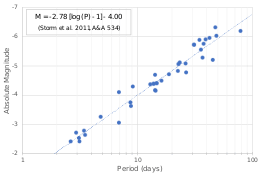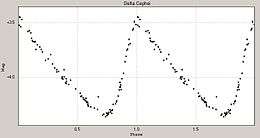Period-luminosity relation
In astronomy, a period-luminosity relation is a relationship linking the luminosity of pulsating variable stars with their pulsation period. The best-known relation is the direct proportionality law holding for Classical Cepheid variables, sometimes called Leavitt's law.[1] Discovered in 1908 by Henrietta Swan Leavitt, the relation established Cepheids as foundational indicators of cosmic benchmarks for scaling galactic and extragalactic distances.[2][3][4][5][6][7] The physical model explaining the Leavitt's law for classical cepheids is called kappa mechanism.

History

Leavitt, a graduate of Radcliffe College, worked at the Harvard College Observatory as a "computer", tasked with examining photographic plates in order to measure and catalog the brightness of stars. Observatory Director Edward Charles Pickering assigned Leavitt to the study of variable stars of the Small and Large Magellanic Clouds, as recorded on photographic plates taken with the Bruce Astrograph of the Boyden Station of the Harvard Observatory in Arequipa, Peru. She identified 1777 variable stars, of which she classified 47 as Cepheids. In 1908 she published her results in the Annals of the Astronomical Observatory of Harvard College, noting that the brighter variables had the longer period.[10] Building on this work, Leavitt looked carefully at the relation between the periods and the brightness of a sample of 25 of the Cepheids variables in the Small Magellanic Cloud, published in 1912.[8] This paper was communicated and signed by Edward Pickering, but the first sentence indicates that it was "prepared by Miss Leavitt".
In the 1912 paper, Leavitt graphed the stellar magnitude versus the logarithm of the period and determined that, in her own words,
A straight line can be readily drawn among each of the two series of points corresponding to maxima and minima, thus showing that there is a simple relation between the brightness of the Cepheid variables and their periods.[8]
Using the simplifying assumption that all of the Cepheids within the Small Magellanic Cloud were at approximately the same distance, the apparent magnitude of each star is equivalent to its absolute magnitude offset by a fixed quantity depending on that distance. This reasoning allowed Leavitt to establish that the logarithm of the period is linearly related to the logarithm of the star's average intrinsic optical luminosity (which is the amount of power radiated by the star in the visible spectrum).[11]
At the time, there was an unknown scale factor in this brightness since the distances to the Magellanic Clouds were unknown. Leavitt expressed the hope that parallaxes to some Cepheids would be measured; one year after she reported her results, Ejnar Hertzsprung determined the distances of several Cepheids in the Milky Way and that, with this calibration, the distance to any Cepheid could then be determined.[11]
The relation was used by Harlow Shapley in 1918 to investigate the distances of globular clusters and the absolute magnitudes of the cluster variables found in them. It was hardly noted at the time that there was a discrepancy in the relations found for several types of pulsating variable all known generally as Cepheids. This discrepancy was confirmed by Edwin Hubble's 1931 study of the globular clusters around the Andromeda Galaxy. The solution was not found until the 1950s, when it was shown that population II Cepheids were systematically fainter than population I Cepheids. The cluster variables (RR Lyrae variables) were fainter still.[12]
The relations
Period-luminosity relations are known for several types of pulsating variable star: type I Cepheids; type II Cepheids; RR Lyrae variables; Mira variables; and other long-period variable stars.[13]
Classical Cepheids

The Classical Cepheid period-luminosity relation has been calibrated by many astronomers throughout the twentieth century, beginning with Hertzsprung.[14] Calibrating the period-luminosity relation has been problematic; however, a firm Galactic calibration was established by Benedict et al. 2007 using precise HST parallaxes for 10 nearby classical Cepheids.[15] Also, in 2008, ESO astronomers estimated with a precision within 1% the distance to the Cepheid RS Puppis, using light echos from a nebula in which it is embedded.[16] However, that latter finding has been actively debated in the literature.[17]
The following relationship between a Population I Cepheid's period P and its mean absolute magnitude Mv was established from Hubble Space Telescope trigonometric parallaxes for 10 nearby Cepheids:
with P measured in days. [18][15] The following relations can also be used to calculate the distance to classical Cepheids, as shown in the page classical cepheid.
Impact

Classical Cepheids (also known as Population I Cepheids, type I Cepheids, or Delta Cepheid variables) undergo pulsations with very regular periods on the order of days to months. Cepheid variables were discovered in 1784 by Edward Pigott, first with the variability of Eta Aquilae,[19] and a few months later by John Goodricke with the variability of Delta Cephei, the eponymous star for classical Cepheids.[20] Most of the Cepheids were identified by the distinctive light curve shape with a rapid increase in brightness and a sharp turnover.
Classical Cepheids are 4–20 times more massive than the Sun[21] and up to 100,000 times more luminous.[22] These Cepheids are yellow bright giants and supergiants of spectral class F6 – K2 and their radii change by of the order of 10% during a pulsation cycle.[23]
Leavitt's work on Cepheids in the Magellanic Clouds led her to discover the relation between the luminosity and the period of Cepheid variables. Her discovery provided astronomers with the first "standard candle" with which to measure the distance to faraway galaxies. Cepheids were soon detected in other galaxies, such as Andromeda (notably by Edwin Hubble in 1923–24), and they became an important part of the evidence that "spiral nebulae" are independent galaxies located far outside of our own Milky Way. Leavitt's discovery provided the basis for a fundamental shift in cosmology, as it prompted Harlow Shapley to move our Sun from the center of the galaxy in the "Great Debate" and Hubble to move our galaxy from the center of the universe. With the period-lumnosity relation providing a way to accurately measure distances on an inter-galactic scale, a new era in modern astronomy unfolded with an understanding of the structure and scale of the universe.[24] The discovery of the expanding universe by Georges Lemaitre and Hubble were made possible by Leavitt's groundbreaking research. Hubble often said that Leavitt deserved the Nobel Prize for her work,[25] and indeed she was nominated by a member of the Swedish Academy of Sciences in 1924, although as she had died of cancer three years earlier she was not eligible.[26][27] (The Nobel Prize is not awarded posthumously.)
References
- "A century of cepheids: Two astronomers, a hundred years apart, use stars to measure the Universe" (Press release). Sloan Digital Sky Survey. 9 January 2018. Retrieved 23 September 2019.
- Udalski, A.; Soszynski, I.; Szymanski, M.; Kubiak, M.; Pietrzynski, G.; Wozniak, P.; Zebrun, K. (1999). "The Optical Gravitational Lensing Experiment. Cepheids in the Magellanic Clouds. IV. Catalog of Cepheids from the Large Magellanic Cloud". Acta Astronomica. 49: 223–317. arXiv:astro-ph/9908317. Bibcode:1999AcA....49..223U.
- Soszynski, I.; Poleski, R.; Udalski, A.; Szymanski, M. K.; Kubiak, M.; Pietrzynski, G.; Wyrzykowski, L.; Szewczyk, O.; Ulaczyk, K. (2008). "The Optical Gravitational Lensing Experiment. The OGLE-III Catalog of Variable Stars. I. Classical Cepheids in the Large Magellanic Cloud". Acta Astronomica. 58: 163. arXiv:0808.2210. Bibcode:2008AcA....58..163S.
- Freedman, Wendy L.; Madore, Barry F.; Gibson, Brad K.; Ferrarese, Laura; Kelson, Daniel D.; Sakai, Shoko; Mould, Jeremy R.; Kennicutt, Jr., Robert C.; Ford, Holland C.; Graham, John A.; Huchra, John P.; Hughes, Shaun M. G.; Illingworth, Garth D.; Macri, Lucas M.; Stetson, Peter B. (2001). "Final Results from the Hubble Space Telescope Key Project to Measure the Hubble Constant". The Astrophysical Journal. 553 (1): 47–72. arXiv:astro-ph/0012376. Bibcode:2001ApJ...553...47F. doi:10.1086/320638.
- Tammann, G. A.; Sandage, A.; Reindl, B. (2008). "The expansion field: the value of H 0". The Astronomy and Astrophysics Review. 15 (4): 289–331. arXiv:0806.3018. Bibcode:2008A&ARv..15..289T. doi:10.1007/s00159-008-0012-y.
- Majaess, D. J.; Turner, D. G.; Lane, D. J. (2009). "Characteristics of the Galaxy according to Cepheids". Monthly Notices of the Royal Astronomical Society. 398 (1): 263–270. arXiv:0903.4206. Bibcode:2009MNRAS.398..263M. doi:10.1111/j.1365-2966.2009.15096.x.
- Freedman, Wendy L.; Madore, Barry F. (2010). "The Hubble Constant". Annual Review of Astronomy and Astrophysics. 48: 673–710. arXiv:1004.1856. Bibcode:2010ARA&A..48..673F. doi:10.1146/annurev-astro-082708-101829.
- Leavitt, Henrietta S.; Pickering, Edward C. (1912). "Periods of 25 Variable Stars in the Small Magellanic Cloud". Harvard College Observatory Circular. 173: 1–3. Bibcode:1912HarCi.173....1L.
- Kerri Malatesta (16 July 2010). "Delta Cephei". American Association of Variable Star Observers.
- Leavitt, Henrietta S. (1908). "1777 variables in the Magellanic Clouds". Annals of Harvard College Observatory. 60: 87–108. Bibcode:1908AnHar..60...87L.
- Fernie, J.D. (December 1969). "The Period–Luminosity Relation: A Historical Review". Publications of the Astronomical Society of the Pacific. 81 (483): 707. Bibcode:1969PASP...81..707F. doi:10.1086/128847.
- Baade, W. (1956). "The Period-Luminosity Relation of the Cepheids". Publications of the Astronomical Society of the Pacific. 68 (400): 5. Bibcode:1956PASP...68....5B. doi:10.1086/126870.
- Sesar, Branimir; Fouesneau, Morgan; Price-Whelan, Adrian M.; Bailer-Jones, Coryn A. L.; Gould, Andy; Rix, Hans-Walter (2017). "A Probabilistic Approach to Fitting Period–luminosity Relations and ValidatingGaia Parallaxes". The Astrophysical Journal. 838 (2): 107. arXiv:1611.07035. Bibcode:2017ApJ...838..107S. doi:10.3847/1538-4357/aa643b.
- Hertzsprung, Ejnar (1913). "Über die räumliche Verteilung der Veränderlichen vom δ Cephei-Typus". Astronomische Nachrichten. 196: 201. Bibcode:1913AN....196..201H.
- Benedict, G. Fritz; McArthur, Barbara E.; Feast, Michael W.; Barnes, Thomas G.; Harrison, Thomas E.; Patterson, Richard J.; Menzies, John W.; Bean, Jacob L.; Freedman, Wendy L. (2007). "Hubble Space Telescope Fine Guidance Sensor Parallaxes of Galactic Cepheid Variable Stars: Period-Luminosity Relations". The Astronomical Journal. 133 (4): 1810. arXiv:astro-ph/0612465. Bibcode:2007AJ....133.1810B. doi:10.1086/511980.
- Kervella, P.; Mérand, A.; Szabados, L.; Fouqué, P.; Bersier, D.; Pompei, E.; Perrin, G. (2008). "The long-period Galactic Cepheid RS Puppis". Astronomy and Astrophysics. 480: 167. arXiv:0802.1501. Bibcode:2008A&A...480..167K. doi:10.1051/0004-6361:20078961.
- Bond, H. E.; Sparks, W. B. (2009). "On geometric distance determination to the Cepheid RS Puppis from its light echoes". Astronomy and Astrophysics. 495 (2): 371. arXiv:0811.2943. Bibcode:2009A&A...495..371B. doi:10.1051/0004-6361:200810280.
- Benedict, G. Fritz; McArthur, B. E.; Fredrick, L. W.; Harrison, T. E.; Slesnick, C. L.; Rhee, J.; Patterson, R. J.; Skrutskie, M. F.; Franz, O. G.; Wasserman, L. H.; Jefferys, W. H.; Nelan, E.; Van Altena, W.; Shelus, P. J.; Hemenway, P. D.; Duncombe, R. L.; Story, D.; Whipple, A. L.; Bradley, A. J. (2002). "Astrometry with the Hubble Space Telescope: A Parallax of the Fundamental Distance Calibrator δ Cephei". The Astronomical Journal. 124 (3): 1695. arXiv:astro-ph/0206214. Bibcode:2002AJ....124.1695B. doi:10.1086/342014.
- Pigott, Edward (1785). "Observations of a new variable star". Philosophical Transactions of the Royal Society. 75: 127–136. Bibcode:1785RSPT...75..127P. doi:10.1098/rstl.1785.0007.
- Goodricke, John (1786). "A series of observations on, and a discovery of, the period of the variation of the light of the star marked δ by Bayer, near the head of Cepheus. In a letter from John Goodricke, Esq. to Nevil Maskelyne, D.D.F.R.S. and Astronomer Royal". Philosophical Transactions of the Royal Society of London. 76: 48–61. Bibcode:1786RSPT...76...48G. doi:10.1098/rstl.1786.0002.
- Turner, David G. (1996). "The Progenitors of Classical Cepheid Variables". Journal of the Royal Astronomical Society of Canada. 90: 82. Bibcode:1996JRASC..90...82T.
- Turner, David G. (2010). "The PL calibration for Milky Way Cepheids and its implications for the distance scale". Astrophysics and Space Science. 326 (2): 219–231. arXiv:0912.4864. Bibcode:2010Ap&SS.326..219T. doi:10.1007/s10509-009-0258-5.
- Rodgers, A. W. (1957). "Radius variation and population type of cepheid variables". Monthly Notices of the Royal Astronomical Society. 117: 85–94. Bibcode:1957MNRAS.117...85R. doi:10.1093/mnras/117.1.85.
- "1912: Henrietta Leavitt Discovers the Distance Key." Everyday Cosmology. N.p., n.d. Web. 20 Oct. 2014. "1912: Henrietta Leavitt Discovers the Distance Key | Everyday Cosmology". Archived from the original on 2014-06-04. Retrieved 2016-10-05.
- Ventrudo, Brian (November 19, 2009). "Mile Markers to the Galaxies". One-Minute Astronomer. Archived from the original on March 12, 2015. Retrieved September 24, 2019.
- Singh, Simon (2005). Big Bang: The Origin of the Universe. Harper Perennial. Bibcode:2004biba.book.....S. ISBN 978-0-00-715252-0.
- Johnson, George (2005). Miss Leavitt's Stars : The Untold Story of the Woman Who Discovered How To Measure the Universe (1st ed.). New York: Norton. ISBN 978-0-393-05128-5.